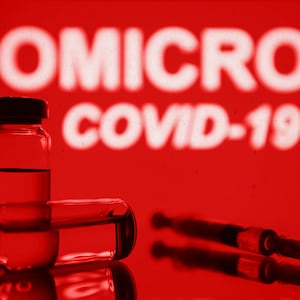Variants like Omicron are bound to arise when not enough people are vaccinated against deadly diseases like COVID-19. The more healthy bodies the novel coronavirus can infect, the more opportunities the virus has to mutate into something that can bypass our best efforts to finally overcome the pandemic. This is especially a concern in places like Africa, where Omicron was first detected, and where vaccination coverage in many countries is just 10 percent or less.
“Failure to reach even a 10 percent vaccination rate in many countries creates ideal conditions for the virus to mutate and evolve, potentially into more lethal, transmissible variants,” Marcus Schabacker, the president and CEO of healthcare nonprofit ECRI, told The Daily Beast.
Part of the problem is logistical—the vaccine needs to be kept very cold until it’s finally given to a patient. This is a nightmare in poorer communities worldwide that lack refrigeration infrastructure. But one way around this could be to freeze-dry vaccines so they can be shipped and stored at room temperature, making it way easier to get vaccines into arms across the planet. That was one big reason vaccination led to the eradication of smallpox.
Now, a breakthrough demonstration by scientists at the University of Buffalo suggests we might soon see a COVID-19 vaccine that we can freeze-dry safely and use to inoculate more of the world with fewer obstacles.
“During the initial rollout of the Pfizer and Moderna vaccines, there was a lot of attention given on the ultracold storage required for those vaccines,” Jonathan Lovell, a biomedical engineer who led the new study with his doctoral student Moustafa Mabrouk, told The Daily Beast. “We asked ourselves whether freeze-drying could be a way to eventually bypass some cold-storage limitations.”
Freeze-drying involves removing water from a frozen product, preserving it for way longer than originally intended, even at room temperatures. Adding water returns the product to its original state, more or less. Think military rations and astronaut food.
But making a freeze-dried vaccine is a different story. For Lovell and Mabrouk, the lynchpin to this approach were liposomes—water-filled sacs of fat. They are already used in several different existing vaccines, including the one that protects against shingles, though no current COVID vaccines use this approach. And the University of Buffalo team had previously shown that liposome-based formulas can be freeze-dried and returned to a liquid status without compromising vaccine effectiveness.
In their new study, published Wednesday in Science Advances, the researchers developed a COVID vaccine that displays the spike protein of the coronavirus on the surface of liposomes. When presented to the body’s immune system, it elicits an immune response just like other COVID vaccines do, they concluded. They also added sucrose, a type of sugar that protects the formula’s integrity during the freeze-drying process.

The team's new COVID-19 vaccine in a freeze-dried state.
Douglas Levere / University at BuffaloWhen freeze-dried, the vaccine looks like a soft, mint green cotton candy. But it was able to withstand ambient and elevated temperatures for at least a week without any problems, the scientists said.
The team even tested the vaccine out on mice, adding water to bring it back to a liquid and then injecting it into mice that carried a copy of the human ACE2 gene (which is responsible for making the protein that allows the coronavirus to invade healthy cells). Those mice were then exposed to live coronavirus. Most immunized mice had undetectable levels of virus and all survived, while many in the unvaccinated group quickly succumbed to infection, according to the study.
Lovell and his colleagues are wasting no time moving these results forward. His company is currently testing a liposome-based COVID vaccine in clinical trials in South Korea with another vaccine maker. While that vaccine candidate uses a slightly different formula than the one employed in this study, Lovell said it should exhibit the same properties under freeze-dried conditions, and it’s likely we could soon see another arm of clinical testing to prove this out.
“Low- and middle-income nations continue to wrestle with acquiring adequate supplies of COVID-19 vaccine as well as managing the cold chain requirements needed to keep the doses that they acquire viable until use,” said Schabacker, who was not involved with the study. “Freeze-drying improvements like what is illustrated in this study might help make it easier to reduce vaccine wastage and increase vaccination rates in these countries, which could reduce the likelihood of variants like Omicron from popping up.”
The world can ill-afford more shocks like the one caused by Omicron in the past week. The only way to prevent scary variants from showing up is to tear down as many vaccination obstacles as possible, and freeze-drying inoculations may prove a powerful tool in achieving just that.







